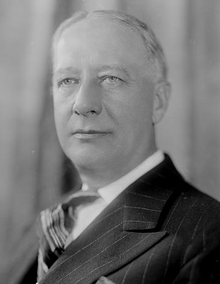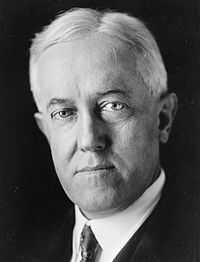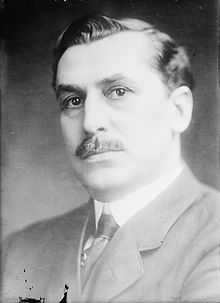1920 Democratic National Convention
| 1920 Presidential Election | |
|---|---|
 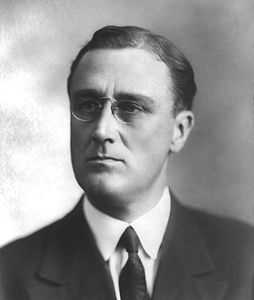 Nominees Cox and Roosevelt | |
| Convention | |
| Date(s) | June 28 - July 6 |
| City | San Francisco, California |
| Venue | Civic Auditorium |
| Candidates | |
| Presidential nominee | James M. Cox of Ohio |
| Vice Presidential nominee | Franklin D. Roosevelt of New York |

The 1920 Democratic National Convention was held at the Civic Auditorium in San Francisco, California from June 28 to July 6, 1920. It resulted in the nomination of Governor James M. Cox of Ohio for President and Assistant Secretary of the Navy Franklin D. Roosevelt from New York for Vice President.
Neither President Woodrow Wilson, in spite of his failing health, nor former Secretary of State and three-time presidential candidate William Jennings Bryan had entirely given up hope that their party would turn to them, but neither was, in the event, formally nominated. In addition to the eventual nominee, Cox, the other high-scoring candidates as the voting proceeded were: Secretary of the Treasury William McAdoo and Attorney General Mitchell Palmer. On the forty-fourth ballot, Governor James M. Cox of Ohio was nominated for the Presidency.[1]
The platform adopted by the convention supported the League of Nations, albeit with qualifications, and women's suffrage.
Democratic candidates
-

Attorney General
Alexander M. Palmer
of Pennsylvania -
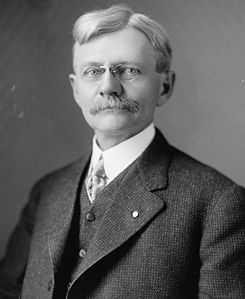
Vice President
Thomas R. Marshall
of Indiana
(Not Formally Nominated) -

Senator
John Sharp Williams
of Mississippi
(Not Formally Nominated) -

President
Woodrow Wilson
of New Jersey
(Not Formally Nominated)

Although William Gibbs McAdoo (Wilson's son-in-law and former Treasury Secretary) was the strongest candidate, Wilson blocked his nomination in hopes a deadlocked convention would demand that he run for a third term, even though he was seriously ill, physically immobile, and in seclusion at the time. The Democrats, meeting in San Francisco between June 28 and July 6 (the first time a major party held its nominating convention in an urban center on the Pacific coast), nominated another newspaper editor from Ohio, Governor James M. Cox, as their presidential candidate, and 38-year-old Assistant Secretary of the Navy Franklin D. Roosevelt, a fifth cousin of the late president Theodore Roosevelt, for vice-president.
Early favorites for the nomination had included McAdoo and Attorney General Alexander Mitchell Palmer. Others placed in nomination included New York Governor Al Smith, United Kingdom Ambassador John W. Davis, New Jersey Governor Edward I. Edwards, and Oklahoma Senator Robert Latham Owen.
Balloting
| (1-22) | Presidential Ballot | ||||||||||||||||||||||||
|---|---|---|---|---|---|---|---|---|---|---|---|---|---|---|---|---|---|---|---|---|---|---|---|---|---|
| 1st | 2nd | 3rd | 4th | 5th | 6th | 7th | 8th | 9th | 10th | 11th | 12th | 13th | 14th | 15th | 16th | 17th | 18th | 19th | 20th | 21st | 22nd | ||||
| James M. Cox | 134 | 159 | 177 | 178 | 181 | 195 | 295.5 | 315 | 321.5 | 321 | 332 | 404 | 428.5 | 443.5 | 468.5 | 454.5 | 442 | 458 | 468 | 456.5 | 426.5 | 430 | |||
| William Gibbs McAdoo | 266 | 289 | 323.5 | 335 | 357 | 368.5 | 384 | 380 | 386 | 285 | 380 | 375.5 | 363.5 | 355.5 | 344.5 | 337 | 332 | 330.5 | 327.5 | 340.5 | 395.5 | 372.5 | |||
| A. Mitchell Palmer | 256 | 264 | 251.5 | 254 | 244 | 265 | 267 | 262 | 257 | 257 | 255 | 201 | 193.5 | 181 | 167 | 164.5 | 176 | 174.5 | 179.5 | 178 | 144 | 166.5 | |||
| Alfred E. Smith | 109 | 101 | 92 | 96 | 95 | 98 | 4 | 2 | 1 | 0 | 0 | 0 | 0 | 0 | 0 | 0 | 0 | 0 | 0 | 0 | 0 | 0 | |||
| Edward I. Edwards | 42 | 34 | 32.5 | 31 | 31 | 30 | 2 | 0 | 0 | 0 | 0 | 0 | 0 | 0 | 0 | 0 | 0 | 0 | 0 | 0 | 0 | 0 | |||
| Thomas R. Marshall | 37 | 36 | 36 | 34 | 29 | 13 | 14 | 12 | 7 | 7 | 7 | 7 | 7 | 7 | 0 | 0 | 0 | 0 | 0 | 0 | 0 | 0 | |||
| Robert L. Owen | 33 | 29 | 22 | 32 | 34 | 36 | 35 | 36 | 37 | 37 | 35 | 34 | 32 | 34 | 31 | 34 | 36 | 38 | 37 | 41 | 36 | 35 | |||
| John W. Davis | 32 | 31.5 | 28.5 | 31 | 29 | 29 | 33 | 32 | 32 | 34 | 33 | 31.5 | 29.5 | 33 | 32 | 52 | 57 | 42 | 31 | 36 | 54 | 52 | |||
| Edwin T. Meredith | 27 | 26 | 26 | 28 | 27 | 0 | 0 | 0 | 0 | 0 | 0 | 0 | 0 | 0 | 0 | 0 | 0 | 0 | 0 | 0 | 0 | 0 | |||
| Carter Glass | 26.5 | 25.5 | 27 | 27 | 27 | 27 | 27 | 27 | 25 | 25 | 25 | 25 | 25 | 25 | 25 | 25 | 27 | 26 | 26 | 26 | 26 | 25 | |||
| Homer Cummings | 25 | 27 | 26 | 24 | 21 | 20 | 19 | 18 | 18 | 19 | 19 | 8 | 7 | 7 | 19 | 20 | 19 | 19 | 19 | 10 | 7 | 6 | |||
| Furnifold M. Simmons | 24 | 25 | 0 | 0 | 0 | 0 | 0 | 0 | 0 | 0 | 0 | 0 | 0 | 0 | 0 | 0 | 0 | 0 | 0 | 0 | 0 | 0 | |||
| James W. Gerard | 21 | 12 | 11 | 2 | 0 | 0 | 0 | 1 | 1 | 2 | 1 | 1 | 0 | 0 | 0 | 0 | 0 | 0 | 1 | 1 | 0 | 0 | |||
| John Sharp Williams | 20 | 0 | 0 | 0 | 0 | 0 | 0 | 0 | 0 | 0 | 0 | 0 | 0 | 0 | 0 | 0 | 0 | 0 | 0 | 0 | 0 | 0 | |||
| Gilbert M. Hitchcock | 18 | 16 | 16 | 5 | 5 | 0 | 0 | 0 | 0 | 0 | 0 | 0 | 0 | 0 | 0 | 0 | 0 | 0 | 0 | 0 | 0 | 0 | |||
| Champ Clark | 9 | 6 | 7 | 8 | 9 | 7 | 8 | 6 | 5 | 4 | 4 | 4 | 4 | 4 | 4 | 4 | 2 | 2 | 2 | 2 | 2 | 2 | |||
| Pat Harrison | 6 | 0 | 6 | 0 | 0 | 0 | 0 | 0 | 0 | 0 | 0 | 0 | 0 | 0 | 0 | 0 | 0 | 0 | 0 | 0 | 0 | 0 | |||
| Leonard Wood | 4 | 0 | 0 | 0 | 0 | 0 | 0 | 0 | 0 | 0 | 0 | 0 | 0 | 0 | 0 | 0 | 0 | 0 | 0 | 0 | 0 | 0 | |||
| William Jennings Bryan | 1 | 1 | 0 | 1 | 0 | 0 | 0 | 0 | 0 | 0 | 0 | 0 | 0 | 0 | 0 | 0 | 0 | 0 | 0 | 0 | 0 | 0 | |||
| Bainbridge Colby | 1 | 0 | 0 | 0 | 2 | 1 | 0 | 0 | 0 | 0 | 0 | 0 | 0 | 0 | 0 | 0 | 0 | 0 | 0 | 0 | 0 | 0 | |||
| Josephus Daniels | 1 | 1 | 1 | 0 | 0 | 0 | 0 | 0 | 0 | 0 | 0 | 0 | 0 | 0 | 0 | 0 | 0 | 0 | 0 | 0 | 0 | 0 | |||
| William Randolph Hearst | 1 | 0 | 0 | 0 | 0 | 0 | 0 | 0 | 0 | 0 | 0 | 0 | 0 | 0 | 0 | 0 | 0 | 0 | 0 | 0 | 0 | 0 | |||
| Oscar Underwood | 0.5 | 0 | 0 | 0 | 0 | 0 | 0 | 0 | 0 | 0 | 0 | 0 | 0 | 0 | 0 | 0 | 0 | 0 | 0 | 0 | 0 | 0 | |||
| Woodrow Wilson | 0 | 0 | 0 | 0 | 0 | 0 | 0 | 0 | 0 | 0 | 0 | 0 | 0 | 0 | 0 | 0 | 0 | 0 | 0 | 0 | 0 | 2 | |||
| (23-44) | Presidential Ballot | ||||||||||||||||||||||||
|---|---|---|---|---|---|---|---|---|---|---|---|---|---|---|---|---|---|---|---|---|---|---|---|---|---|
| 23rd | 24th | 25th | 26th | 27th | 28th | 29th | 30th | 31st | 32nd | 33rd | 34th | 35th | 36th | 37th | 38th | 39th | 40th | 41st | 42nd | 43rd | 44th | ||||
| James M. Cox | 425 | 429 | 424 | 424.5 | 423.5 | 423 | 404.5 | 400.5 | 391.5 | 391 | 380.5 | 379.5 | 376.5 | 377 | 386 | 383.5 | 468.5 | 490 | 497.5 | 540.5 | 568 | 699.5 | |||
| William Gibbs McAdoo | 364.5 | 364.5 | 364.5 | 371 | 371.5 | 368.5 | 394.5 | 403.5 | 415.5 | 421 | 421 | 420.5 | 409 | 399 | 405 | 405.5 | 440 | 467 | 460 | 427 | 412 | 270 | |||
| A. Mitchell Palmer | 181.5 | 177 | 169 | 167 | 166.5 | 165.5 | 166 | 165 | 174 | 176 | 180 | 184 | 222 | 241 | 202.5 | 211 | 74 | 19 | 12 | 8 | 7 | 1 | |||
| John W. Davis | 50.5 | 54.5 | 58.5 | 55.5 | 60.5 | 62.5 | 63 | 58 | 57.5 | 55.5 | 56 | 54 | 33 | 28 | 50.5 | 50 | 71.5 | 76 | 55.5 | 49.5 | 57.5 | 52 | |||
| Robert L. Owen | 34 | 33 | 34 | 33 | 34 | 35.5 | 33 | 33 | 34 | 34 | 34 | 37 | 38.5 | 36 | 33 | 33 | 32 | 33 | 35 | 34 | 34 | 34 | |||
| Carter Glass | 25 | 25 | 25 | 25 | 25 | 24 | 24 | 24 | 12.5 | 9.5 | 13 | 7.5 | 5 | 4 | 1 | 1 | 0 | 0 | 24 | 24 | 5.5 | 1.5 | |||
| Homer Cummings | 5 | 5 | 4 | 3 | 3 | 4 | 4 | 4 | 3 | 3 | 3 | 3 | 3 | 3 | 3 | 4 | 2 | 2 | 2 | 3 | 2 | 0 | |||
| Champ Clark | 2 | 2 | 2 | 3 | 2 | 2 | 2 | 2 | 2 | 2 | 2.5 | 2.5 | 2 | 2 | 2 | 3 | 2 | 2 | 2 | 2 | 2 | 0 | |||
| Annette Abbott Adams | 0 | 0 | 0 | 0 | 0 | 0 | 0 | 0 | 0 | 0 | 0 | 0 | 0 | 0 | 1 | 0 | 0 | 0 | 0 | 0 | 0 | 0 | |||
| Eugene C. Bonniwell | 0 | 0 | 0 | 1 | 0 | 0 | 0 | 0 | 0 | 0 | 0 | 0 | 0 | 0 | 1 | 0 | 0 | 0 | 0 | 0 | 0 | 0 | |||
| William Jennings Bryan | 0 | 0 | 0 | 1 | 0 | 0 | 0 | 0 | 0 | 0 | 0 | 0 | 0 | 0 | 0 | 0 | 0 | 0 | 0 | 0 | 0 | 0 | |||
| Laura Clay | 0 | 0 | 0 | 0 | 0 | 0 | 0 | 0 | 0 | 0 | 1 | 0 | 0 | 0 | 0 | 0 | 0 | 0 | 0 | 0 | 0 | 0 | |||
| Irvin S. Cobb | 1.5 | 0 | 0 | 0 | 0 | 0 | 0 | 0 | 0 | 0 | 0 | 0 | 0 | 0 | 0 | 0 | 0 | 0 | 0 | 0 | 0 | 0 | |||
| Bainbridge Colby | 0 | 0 | 0 | 0 | 0 | 0 | 0 | 0 | 0 | 0 | 0 | 0 | 0 | 0 | 0 | 0 | 1 | 1 | 1 | 1 | 1 | 1 | |||
| Josephus Daniels | 0 | 0 | 0 | 0 | 0 | 0 | 0 | 0 | 1 | 0 | 0 | 0 | 0 | 0 | 0 | 0 | 0 | 0 | 0 | 0 | 0 | 0 | |||
| Walker Hines | 0 | 0 | 0 | 0 | 0 | 1 | 0 | 0 | 0 | 0 | 0 | 0 | 0 | 0 | 0 | 0 | 0 | 0 | 0 | 0 | 0 | 0 | |||
| Andrieus A. Jones | 0 | 0 | 0 | 1 | 0 | 0 | 0 | 0 | 0 | 0 | 0 | 0 | 0 | 0 | 0 | 0 | 0 | 0 | 0 | 0 | 0 | 0 | |||
| Ring Lardner | 0.5 | 0 | 0 | 0 | 0 | 0 | 0 | 0 | 0 | 0 | 0 | 0 | 0 | 0 | 0 | 0 | 0 | 0 | 0 | 0 | 0 | 0 | |||
| James H. Lewis | 0 | 0 | 0 | 1 | 0 | 0 | 0 | 0 | 0 | 0 | 0 | 0 | 0 | 0 | 6 | 0 | 0 | 0 | 0 | 0 | 0 | 0 | |||
| Thomas R. Marshall | 0 | 0 | 0 | 0 | 1 | 0 | 0 | 0 | 1 | 0 | 0 | 0 | 0 | 0 | 0 | 0 | 0 | 0 | 0 | 0 | 0 | 0 | |||
| John J. Pershing | 0 | 0 | 1 | 0 | 0 | 0 | 0 | 0 | 0 | 0 | 0 | 0 | 0 | 0 | 0 | 0 | 0 | 0 | 0 | 0 | 0 | 0 | |||
| Joseph T. Robinson | 0 | 0 | 0 | 0 | 1 | 0 | 0 | 0 | 0 | 0 | 0 | 0 | 0 | 0 | 0 | 0 | 0 | 0 | 0 | 0 | 0 | 0 | |||
| Cora Wilson Stewart | 0 | 0 | 0 | 0 | 0 | 0 | 0 | 0 | 0 | 0 | 0 | 0 | 0 | 1 | 0 | 0 | 0 | 0 | 0 | 0 | 0 | 0 | |||
| Oscar Underwood | 0 | 1 | 9 | 9 | 4 | 6 | 1 | 2 | 0 | 0 | 0 | 0 | 0 | 0 | 0 | 0 | 0 | 0 | 0 | 0 | 0 | 0 | |||
Vice presidential nomination
It seemed that this was going to be a free for all too, but Cox had asked the delegates to support former Assistant Navy Secretary Franklin D. Roosevelt, because, as some thought, he had a "magic name." FDR was nominated by voice vote and received the nomination by acclamation.[2]
See also
- 1920 Republican National Convention
- United States presidential election, 1920
- Democratic National Convention
| Preceded by 1916 |
Democratic National Conventions | Succeeded by 1924 |
References
- ↑ Pietrusza, David. 1920: The Year of the Six Presidents. New York, Carroll and Graf, 2007.
- ↑ Staff writer(s) (July 6, 1920). "Roosevelt Given Second Place; Convention Ends". San Francisco Chronicle (San Francisco, CA). Retrieved February 26, 2015 – via Newspapers.com.

External links
| ||||||||||||||||||||||||||||||||||||||||||

